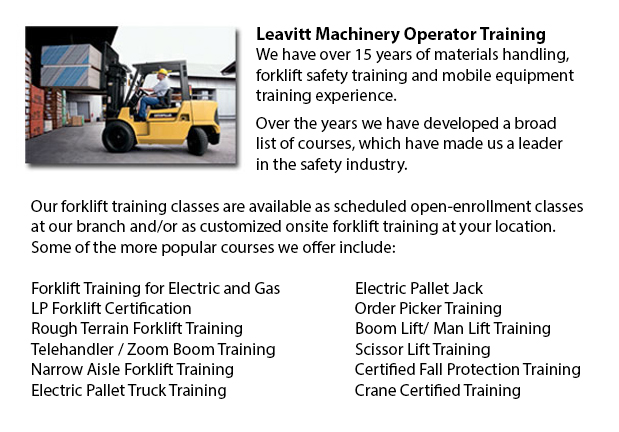
Forklift Training Schools Regina - Have A Safe And Efficient Work Place With Our Forklift Training Schools
Are you searching for a job as a driver of a forklift? Our regulatory-compliant mobile equipment operator training provides instruction in types of forklifts, pre-shift check, fuel kinds and handling of fuels, and safe utilization of a lift truck. Practical, hands-on training helps people participating in obtaining basic operational skills. Course content includes current regulations governing the utilization of lift trucks. Our proven forklift courses are intended to offer training on these types of trucks: powered pallet truck, narrow isle forklift and counterbalanced forklift.
Whilst the lift truck is in use, do not raise or lower the forks. Loads should not extend higher than the backrest. This is because of the possibility of the load sliding back towards the operator. Check for overhead obstacles and ensure there is adequate clearance before raising a load. Stay away from overhead power lines. Once the load is raised straight up, tilt it back slightly.
When the load is raised the forklift will be less stable. Make certain that no pedestrians cross underneath the elevated fork. The operator should not leave the forklift when the load is raised.
While handling pallets, forks must be high and level enough to go into the pallet and extend all the way below the load. The width of the forks should provide even distribution of weight.
Prior to loading or unloading the truck, set the brakes and chock the wheels. Floors must be strong enough to support the weight of the forklift and the load combined. Fixed jacks could be installed in order to support a semi-trailer that is not coupled to a tractor. The entrance door height should clear the height of the forklift by at least 5 cm. Mark edges of rail cars, ramps or docks and avoid them.
-
Forklift Training Classes Regina
Forklift Training Classes Regina - Forklifts are a kind of heavy lifting equipment used in order to move and handle material efficiently and safely. Sometimes called Lift Trucks, they are made use of in different industries. Employees working with an... More -
Crane Certification Regina
Crane Certification Regina - The Crane Certification Program covers the industry suggested content which would teach the safe and efficient operation of cranes. The person will train in the following: pre-operational, operational and post operating r... More -
Telehandler Training Courses Regina
Telehandler Training Courses Regina - Employers are responsible for making sure that their operating personnel and supervisors are trained to work proficiently utilizing telehandler machines. The competence level of employees need to be assessed. If... More -
Operator Safety Training, Re-Qualification Training, In-House Instructor Training in Regina
Lift trucks are utilized in just about all industrial construction sites and in warehouse operations and in boat yards. The reach feature of a lift truck is a very important component utilized in a variety of applications like for instance when a she... More -
Heavy Equipment Operator Training Regina
Heavy Equipment Operator Training Regina - Training facilities that offer good standards in the business and not only provide field performing tasks but additional equipment training are highly sought after. Accredited schools offer students the know... More -
Wheel Loader Operator Training Regina
Wheel Loader Operator Training Regina - Cranes are industrial machines which make use of pulleys or levers so as to lift considerable loads. The Roman people utilized cranes in order to put up big monuments, that means these machines have been existi... More -
Crane Safety Training Regina
Crane Safety Training Regina - Both crane driver as well as their supervisors need to know all the possible problems connected to the operation of an overhead crane. All over North America, there is legislation that provides regulation for the safe o... More -
Scissor Lift Safety Training Regina
Scissor Lift Safety Training Regina - A Scissor Lift is a functional kind of platform that normally moves in a vertical direction. The machinery is capable of this movement due to the use of folding supports that are linked in a criss-cross pattern c... More

Forklift Training Regina
TOLL FREE: 1-888-254-6157
Regina, Saskatchewan
forklifttrainingregina.com
Email Us
About Us



